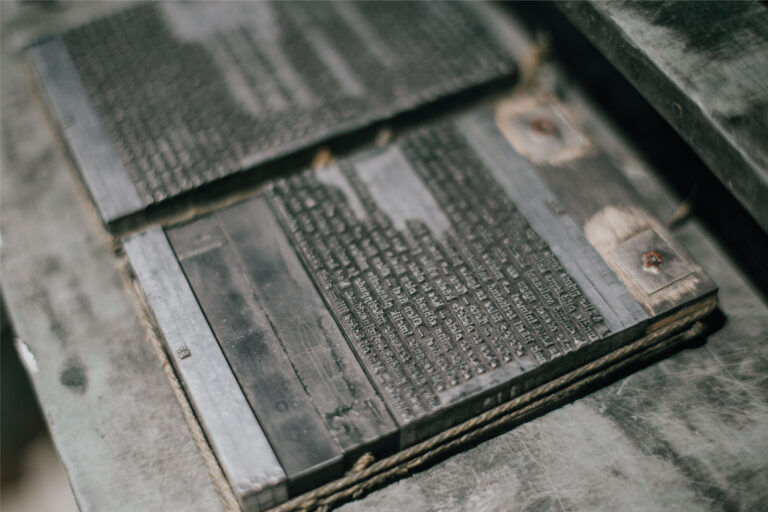You must be curious to know how exactly we printed the book if we only used the techniques and machines from the 20th century or earlier.
COMPOSING AND PROOFING (AND COMPOSING AND PROOFING)
After the layout and the design of the book had been confirmed, our printing technician Jörgen could start composing the text for the book. To do this, we used our line casting machine called The Linotype.
The Linotype, invented in 1880, was one of the most important machines in a 20th-century printshop. Before this invention, all the text for books or newspapers had to be composed by hand out of single pieces of metal type, letter by letter. Linotype made this job much faster: the machine operator simply types the text on a keyboard, the machine assembles matrices in a line and then casts this line from molten metal.
To be true, the machine that we used to cast the lines for the book was not a real Linotype but a Soviet copy of the same machine, called N-14. By now we also have a real Linotype in our collection. (Dont’ worry – they both work just as well!)


For our The Little Prince book we had to use a few hundred kilograms of metal to cast several thousand of lines of text. You can see our printing technician, Jörgen, operating the line casting machine in this video:
Once the lines were cast, we made proof prints so the editor could find all the typos and errors. After this, Jörgen recast all the lines with typos. Sometimes this meant he had to recast the whole paragraph and sometimes new typos were made while correcting these lines. So the composing > proof print > proofing > back to composing circle went on several times.
While most of the text was prepared with the Linotype, the title of the book and dedications (for the gift editions) were composed by hand. For that, we used the Admiral font from our movable type collection. Hand setting type is time-consuming, and the compositor doing it has to compose the text in a mirror. The type itself is also backwards as printing will produce a mirrored image.

IMPOSING, PACKING, FINAL PROOFING & PRINTING
Once all the text was proof-read and corrected, we could assemble the text lines and illustration clichés into pages. After that, the pages were imposed – moved into the machine and arranged with respect to one another. Since we were going to print 16 pages at a time, they had to be placed in the machine in a way which – after folding and binding – they would end up in a logical order.




The next step was adjusting the pressure and packing around the pressure cylinder of the printing machine. This step is important to make sure that all the text and illustrations are printed evenly, with just the right amount of pressure. After this, our pressman Jörgen made the final proofprint for our editor to check everything (layout, text, pressure) was perfect. When this was confirmed, these first 16 pages were finally ready to print. See us using Victoria in this video:
You need two people for printing: a pressman who operates the machine and another person who checks the quality of the prints that come out from the back of the machine. We printed 300 copies of these first 16 pages before we could take them out from the machine and start all over again with pages 17-32. In total we did this 6 times.
PRINTING THE DUST JACKETS
While the book has predominantly black-and-white illustrations, we decided to give a little bit extra attention to the dust-jackets and print those in four colours. Our old machines can only print one colour at a time. This meant that all four colours – yellow, beige, black and bue – had to be printed separately. The pressman Jörgen had to be extra careful here to make sure all the details match perfectly.

PRINTING THE ENDPAPERS
Endpapers are the very first and last pages of a hardcover book which are used to attach the book block between the covers. We decided to print a nice starry pattern on them. For this, we reused the clichés with small stars and planets – the same which were used to print the illustrations found between chapters.


HARDCOVERS
The first 150 copies of the book (Collector’s, gift and hands-on edition) are hand-bound at TYPA and the covers for those are printed in silkscreen, also by us.
The rest of the 150 copies (Letterpress edition) were finished by a local modern printshop who also printed the covers in hot-foil technique:
